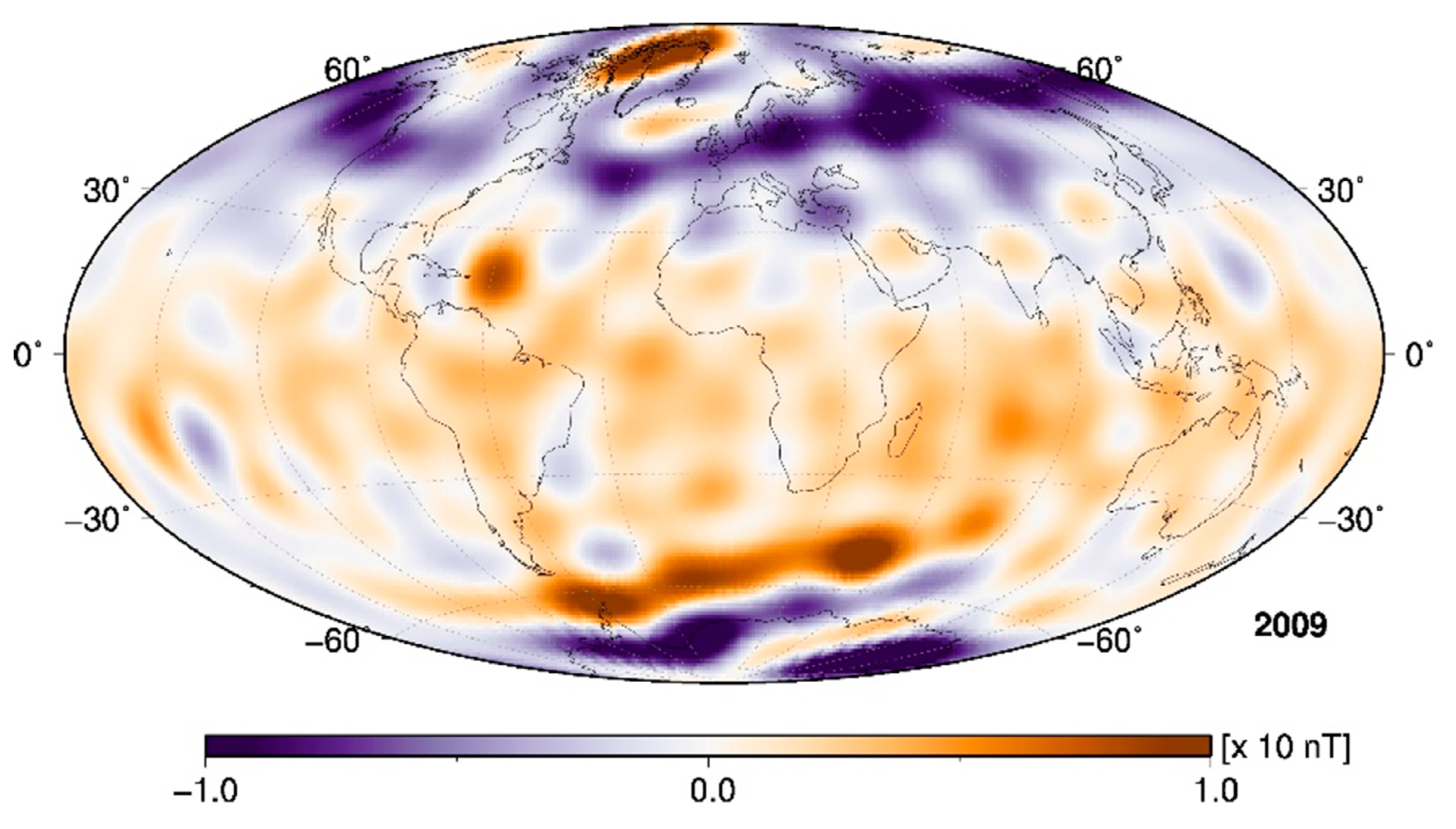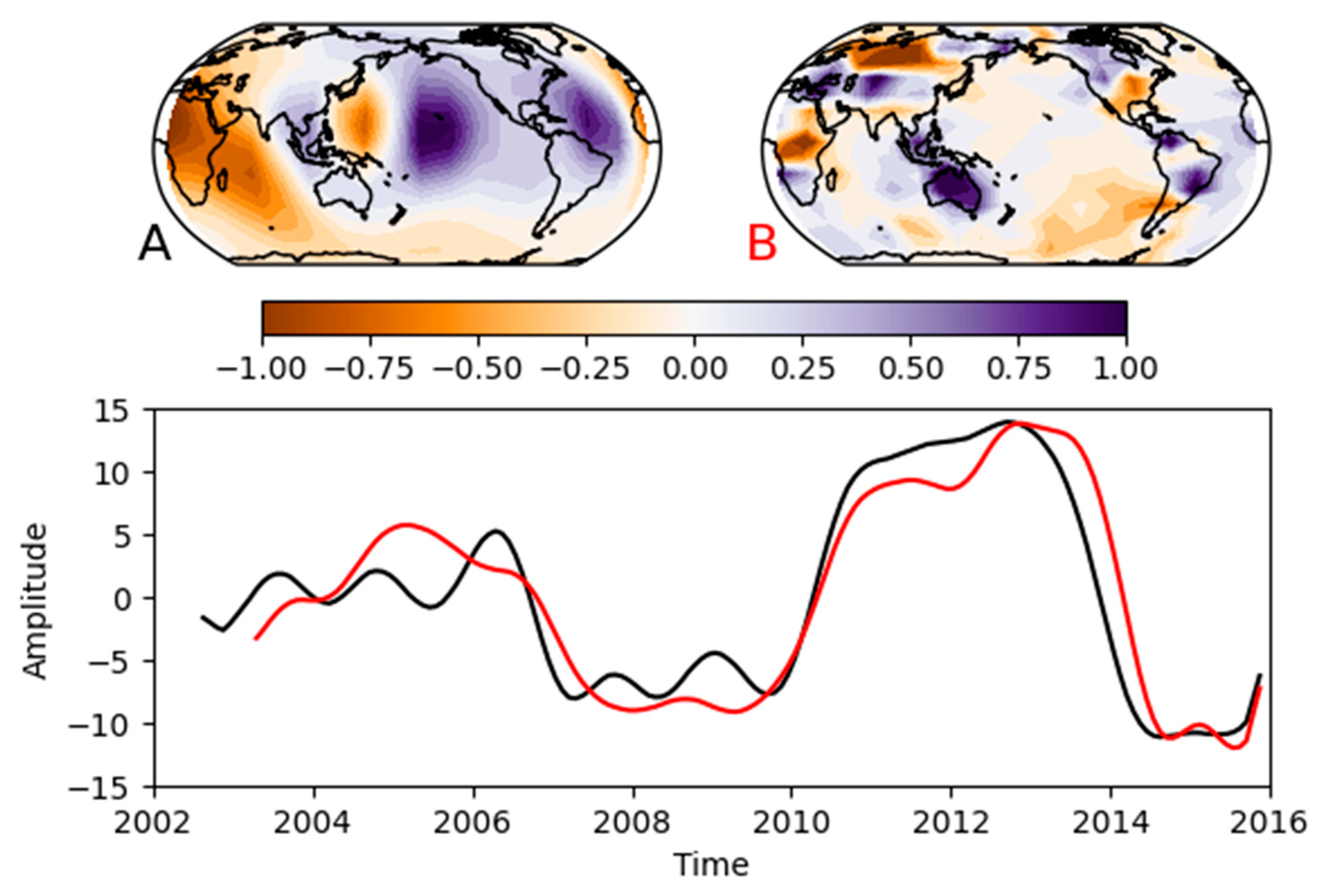GRACE—Gravity Data for Understanding the Deep Earth’s Interior
Abstract
1. Introduction
2. Materials and Methods
2.1. Magnetic Field Data Analysis
2.2. Gravity Field Data Analysis
2.2.1. GRACE Fields
2.2.2. Atmospheric Loading and Associated Ocean Bottom Pressure
2.2.3. Hydrological Component
2.2.4. Land Ice Component
2.2.5. Ocean Mass Change
2.2.6. GIA and Other Static Factors
2.2.7. Remaining Effects—Core Effects
3. Results
4. Discussion
Author Contributions
Funding
Acknowledgments
Conflicts of Interest
References
- Mandea, M.; Panet, I.; Lesur, V.; De Viron, O.; Diament, M.; Le Mouël, J.-L. Recent changes of the Earth’s core derived from satellite observations of magnetic and gravity fields. Proc. Natl. Acad. Sci. USA 2012, 109, 19129–19133. [Google Scholar] [CrossRef] [PubMed]
- Mandea, M.; Narteau, C.; Panet, I.; Le Mouël, J.-L. Gravimetric and magnetic anomalies produced by dissolution-crystallization at the core-mantle boundary. J. Geophys. Res. Solid Earth 2015, 120, 5983–6000. [Google Scholar] [CrossRef]
- Cox, C.; Chao, B.F. Detection of large-scale mass redistribution in the terrestrial system since 1998. Science 2002, 297, 831–833. [Google Scholar] [CrossRef] [PubMed]
- Cheng, M.; Ries, J.C.; Tapley, B.D. Variations of the Earth’s figure axis from satellite laser ranging and GRACE. J. Geophys. Res. 2011, 116, B01409. [Google Scholar] [CrossRef]
- Meyssignac, B.; Lemoine, J.M.; Cheng, M.; Cazenave, A.; Gegout, P.; Maisongrande, P. Interannual variations in degree-two Earth’s gravity coefficients C2,0, C2,2 and S2,2 reveal large-scale mass transfers of climatic origin. Geophys. Res. Lett. 2013, 40, 1–6. [Google Scholar] [CrossRef]
- Wahr, J.M. Time-Variable Gravity from Satellites. Treatise Geophys. 2015, 3, 193–213. [Google Scholar] [CrossRef]
- Tapley, B.; Watkins, M.; Flechtner, F.; Reigber, C.; Bettadpur, S.; Rodell, M.; Sasgen, I.; Famiglietti, J.S.; Landerer, F.W.; Chambers, D.P.; et al. Contributions of GRACE to understanding climate change. Nat. Clim. Chang. 2019, 5, 358–369. [Google Scholar] [CrossRef]
- Cazenave, A.; Souriau, A.; Dominh, K. Global coupling of Earth surface topography with hotspots, geoid and mantle heterogeneities. Nature 1989, 340, 54–57. [Google Scholar] [CrossRef]
- Panet, I.; Mikhailov, V.; Diament, M.; Pollitz, F.; King, G.; de Viron, O.; Holschneider, M.; Biancale, R.; Lemoine, J.-M. Coseismic and post-seismic signatures of the Sumatra 2004 December and 2005 March earthquakes in GRACE satellite gravity. Geophys. J. Int. 2007, 171, 177–190. [Google Scholar] [CrossRef]
- de Viron, O.; Panet, I.; Mikhailov, V.; Van Camp, M.; Diament, M. Retrieving earthquake signature in GRACE gravity solutions. Geophys. J. Int. 2008, 174, 14–20. [Google Scholar] [CrossRef]
- Peltier, W.R. Global glacial isostasy and the surface of the ice-age Earth: The ICE-5G (VM2) model and GRACE. Annu. Rev. Earth Planet. Sci. 2004, 32, 111–149. [Google Scholar] [CrossRef]
- Tamisiea, M.E. Ongoing glacial isostatic contributions to observations of sea level change. Geophys. J. Int. 2011, 186, 1036–1044. [Google Scholar] [CrossRef]
- Adhikari, S.; Ivins, E.R.; Frederikse, T.; Landerer, F.W.; Caron, L. Sea level fingerprints emergent from GRACE mission data. ESSD 2019, 11, 629–646. [Google Scholar] [CrossRef]
- Lesur, V.; Rother, M.; Vervelidou, F.; Hamoudi, M.; Thébault, E. Post-processing scheme for modeling the lithospheric magnetic field. Solid Earth Discuss. 2012, 4, 1345–1378. [Google Scholar] [CrossRef]
- Finlay, C.C.; Olsen, N.; Kotsiaros, S.; Gillet, N.; Toffner-Clausen, L. Recent geomagnetic secular variation from Swarm and ground observatories as estimated in the CHAOS-6 geomagnetic field model. Earth Planets Space 2016, 68. [Google Scholar] [CrossRef]
- Wardinski, I.; Holme, R. Signal from noise in geomagnetic field modelling: Denoising data for secular variation studies. Geophys. J. Int. 2011, 185, 653–662. [Google Scholar] [CrossRef]
- Cox, G.A.; Brown, W.J.; Billingham, L.; Holme, R. MagPySV: A Python package for processing and denoising geomagnetic observatory data. Geochem. Geophys. Geosyst. 2018, 19. [Google Scholar] [CrossRef]
- Stammer, D.; Cazenave, A.; Ponte, R.; Tamisiea, M. Contemporary regional sea level changes. Annu. Rev. Mar. Sci. 2013, 5, 21–46. [Google Scholar] [CrossRef]
- Blazquez, A.; Meyssignac, B.; Lemoine, J.M.; Berthier, E.; Ribes, A.; Cazenave, A. Exploring the uncertainty in GRACE estimates of the mass redistributions at the Earth surface: Implications for the global water and sea level budgets. Geophys. J. Int. 2018, 215, 415–430. [Google Scholar] [CrossRef]
- Swenson, S.; Chambers, D.; Wahr, J. Estimating geocenter variations from a combination of GRACE and ocean model output. J. Geophys. Res. 2008, 113. [Google Scholar] [CrossRef]
- Cheng, M.; Tapley, B.D.; Ries, J.C. Deceleration in the Earth’s oblateness. J. Geophys. Res. 2013, 118, 740–747. [Google Scholar] [CrossRef]
- Geruo, A.; Wahr, J.; Zhong, S. Computations of the viscoelastic response of a 3-D compressible Earth to surface loading: An application to Glacial Isostatic Adjustment in Antarctica and Canada. Geophys. J. Int. 2013, 192, 557–572. [Google Scholar]
- Cazenave, A.; Dieng, H.; Meyssignac, B.; von Schuckmann, K.; Decharme, B.; Berthier, E. The rate of sea level rise. Nat. Clim. Chang. 2014, 2014, 358–361. [Google Scholar] [CrossRef]
- Reager, J.T.; Gardner, A.S.; Famiglietti, J.S.; Wiese, D.N.; Eicker, A.; Lo, M.H. A decade of sea level rise slowed by climate-driven hydrology. Science 2016, 351, 699–703. [Google Scholar] [CrossRef]
- Scanlon, B.; Zhang, R.; Save, Z.; Sun, H.; Schmied, A.Y.; van Beek, H.M.; Longuevergne, L. Global models underestimate large decadal declining and rising water storage trends relative to GRACE satellite data. Proc. Natl. Acad. Sci. USA 2018, 115, E1080–E1089. [Google Scholar] [CrossRef]
- Doell, P.; Douville, H.; Güntner, A.; Müller Schmied, H.; Wada, Y. Modelling freshwater resources at the global scale: Challenges and prospects. Surv. Geophys. 2017, 37, 195–221. [Google Scholar] [CrossRef]
- Marzeion, B.; Champollion, N.; Haeberli, W.; Langley, K.; Leclercq, P.; Paul, F. Observation-Based Estimates of Global Glacier Mass Change and Its Contribution to Sea-Level Change. Surv. Geophys. 2017, 28, 105–130. [Google Scholar] [CrossRef]
- Bamber, J.L.; Westaway, R.M.; Marzeion, B.; Wouters, B. The land ice contribution to sea level during the satellite era. Environ. Res. Lett. 2018, 13, 063008. [Google Scholar] [CrossRef]
- WCRP Global Sea Level Budget Group. Global sea level budget, 1993-present. Earth Syst. Sci. Data 2018, 10, 1551–1590. [Google Scholar] [CrossRef]
- Legeais, J.F.; Ablain, M.; Zawadzki, L.; Zuo, H.; Johannessen, J.A.; Scharffenberg, M.G.; Fenoglio-Marc, L.; Fernandes, J.; Andersen, O.B.; Rudenko, S.; et al. An improved and homogeneous altimeter sea level record from the ESA Climate Change Initiative. Earth Syst. Sci. Data 2018, 10, 281–301. [Google Scholar] [CrossRef]
- Von Schuckman, K.; Le Traon, P.-Y.; Smith, N.; Pascual, A.; Djavidnia, S.; Gattuso, J.-P.; Marilaure, G.; Nolan, G.; Aaboe, S.; Aguiar, E.; et al. Copernicus Marine Service Ocean State Report, Issue 3. J. Oper. Oceanogr. 2019, 12 (Suppl. S1), 1–123. [Google Scholar] [CrossRef]
- Stuhne, G.R.; Peltier, W.R. Reconciling the ICE-6G C reconstruction of glacial chronology with ice sheet dynamics: The cases of Greenland and Antarctica. J. Geophys. Res. 2015, 120, 1841–1865. [Google Scholar] [CrossRef]
- Preisendorfer, R.W. Principal Component Analysis in Meteorology and Oceanography. Dev. Atmos. Sci. 1988, 17, XVIII-425. [Google Scholar]
- Dehant, V.; Wahr, J.M. The response of a compressible, non-homogeneous Earth to internal loading: Theory. J. Geomagn. Geoelectr. 1991, 43, 157–178. [Google Scholar] [CrossRef][Green Version]
- Poirier, J.P.; Le Mouël, J.-L. Does infiltration of core material into the lower mantle affect the observed geomagnetic field? Phys. Earth Planet. Inter. 1992, 73, 29–37. [Google Scholar] [CrossRef]
- Storch, H.; Zwiers, F. Statistical Analysis in Climate Research; Cambridge University Press: Cambridge, UK, 1999. [Google Scholar] [CrossRef]
- Mandea, M.; Holme, R.; Pais, A.; Pinheiro, K.; Jackson, A.; Verbanac, G. Geomagnetic Jerks: Rapid Core Field Variations and Core Dynamics. Space Sci. Rev. 2010, 155, 147–175. [Google Scholar] [CrossRef]
- Olsen, N.; Mandea, M.; Sabaka, T.J.; Tøffner-Clausen, L. CHAOS-2–A geomagnetic field model derived from one decade of continuous satellite data. Geophys. J. Int. 2009, 179, 1477–1487. [Google Scholar] [CrossRef]
- Torta, J.M.; Pavon-Carrasco, F.J.; Marsal, S.; Finlay, C.C. Evidence for a new geomagnetic jerk in 2014. Geophys. Res. Lett. 2015, 42, 7933–7940. [Google Scholar] [CrossRef]
- Ghil, M.; Allen, R.M.; Dettinger, M.D.; Ide, K.; Kondrashov, D.; Mann, M.E.; Robertson, A.W.; Saunders, A.; Tian, Y.; Varadi, F. Advanced spectral methods for climatic time series. Rev. Geophys. 2002, 40, 3.1–3.41. [Google Scholar] [CrossRef]


Publisher’s Note: MDPI stays neutral with regard to jurisdictional claims in published maps and institutional affiliations. |
© 2020 by the authors. Licensee MDPI, Basel, Switzerland. This article is an open access article distributed under the terms and conditions of the Creative Commons Attribution (CC BY) license (http://creativecommons.org/licenses/by/4.0/).
Share and Cite
Mandea, M.; Dehant, V.; Cazenave, A. GRACE—Gravity Data for Understanding the Deep Earth’s Interior. Remote Sens. 2020, 12, 4186. https://doi.org/10.3390/rs12244186
Mandea M, Dehant V, Cazenave A. GRACE—Gravity Data for Understanding the Deep Earth’s Interior. Remote Sensing. 2020; 12(24):4186. https://doi.org/10.3390/rs12244186
Chicago/Turabian StyleMandea, Mioara, Véronique Dehant, and Anny Cazenave. 2020. "GRACE—Gravity Data for Understanding the Deep Earth’s Interior" Remote Sensing 12, no. 24: 4186. https://doi.org/10.3390/rs12244186
APA StyleMandea, M., Dehant, V., & Cazenave, A. (2020). GRACE—Gravity Data for Understanding the Deep Earth’s Interior. Remote Sensing, 12(24), 4186. https://doi.org/10.3390/rs12244186




